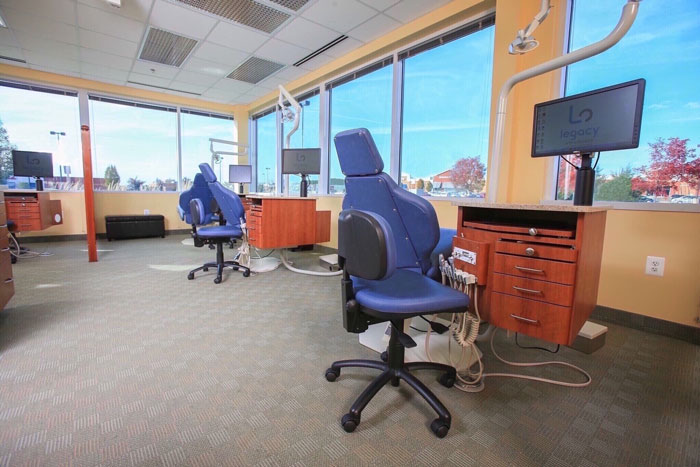The 10-Minute Rule for Legacy Orthodontics
The 10-Minute Rule for Legacy Orthodontics
Blog Article
Getting My Legacy Orthodontics To Work
Table of ContentsThe Facts About Legacy Orthodontics UncoveredSome Ideas on Legacy Orthodontics You Should KnowThe 9-Minute Rule for Legacy OrthodonticsA Biased View of Legacy OrthodonticsWhat Does Legacy Orthodontics Do?
In addition, we provide adjustable treatment timetables, versatile payment choices and a fun, delightful experience.An orthodontist is a dentist trained to identify, stop, and deal with teeth and jaw irregularities. Orthodontists work with individuals of all ages, from children to grownups.
Malocclusion, or misaligned teeth, can lead to dental problems, including dental cavity, gum illness, and tough or agonizing eating. Not everyone is born with straight teeth. If you have a negative bite or big spaces in between your teeth, you may desire to seek advice from a dental expert concentrating on orthodontic care.
The Best Guide To Legacy Orthodontics
( Picture Credit Score: DigitalVision/Getty Images) Orthodontists use fixed and detachable dental tools, like dental braces, retainers, and bands, to transform the position of teeth in your mouth. Orthodontic therapy is for dental problems, consisting of: Misaligned teethBite troubles, like an overbite or an underbiteCrowded teeth or teeth that are as well much apartJaw misalignmentThe goal of orthodontic treatment is to improve your bite.
A healthy bite guarantees you can eat, eat, and speak effectively. While you could think about orthodontists as mostly for kids or young adults that need dental braces, they can fix dental problems at any age. Orthodontists go to university, oral institution, and orthodontic school. After college graduation, they spend 2 or 3 years in an orthodontic residency program.
All orthodontists are dental experts, yet not all dental practitioners are orthodontists. Orthodontic residency programs supply extensive, concentrated instruction for dental specialists. They concentrate on 2 areas: How to appropriately and safely move teeth How to properly guide advancement in the teeth, jaw, and faceOnce an orthodontist has completed training, they have the choice to come to be board licensed.
The Facts About Legacy Orthodontics Revealed
Misalignment, or malocclusion, is one of the most typical reason individuals see an orthodontist. It is hereditary and is the result of dimension differences between the upper and reduced jaw or between the jaw and teeth. Malocclusion causes tooth overcrowding, an irregular jaw, or irregular bite patterns. Malocclusion is generally treated with: Your orthodontist connects steel, ceramic, or plastic square bonds to your teeth.
If you have only small malocclusion, you may have the ability to use clear dental braces, called aligners, as opposed to traditional dental braces (https://www.callupcontact.com/b/businessprofile/Legacy_Orthodontics/9435468). Some people need a headwear to help move teeth into line with pressure from outside the mouth. After dental braces or aligners, you'll require to wear a retainer. A retainer is a personalized gadget that maintains your teeth in place.
They can produce extra room in the mouth without having to draw teeth. Orthodontists make use of cables, surgical screws, or plates to sustain your jaw bone.
You may need to see an orthodontist if you have: Crowding or not adequate space for every one of your teethOverbite, when your upper teeth come your base teethUnderbite, when your base teeth are also much forwardSpacing or issues with gapsCrossbite, which is when your upper teeth fit behind your bottom teeth when your mouth is closedOpen bite or an upright void between your front bottom and upper teethMisplaced midline, when the facility of your bottom and upper teeth don't align Correcting an oral malocclusion can: Make biting, eating, and talking easierImprove the proportion of our face and your general appearanceEase pain from temporomandibular joint disordersDifferent your teeth and make them simpler to clean, aiding stop dental cavity or dental caries It's usually a dental expert who first notices misaligned teeth throughout a routine test.
Legacy Orthodontics for Beginners

During your first orthodontic appointment, you'll likely have: A dental examPhotos taken of your face and smileDental X-raysPanoramic (360 level) X-rays of your face and headImpressions to produce mold and mildews of your teethThese tests will certainly help your orthodontist recognize exactly how to wage your treatment. clear braces. An orthodontist is a dental practitioner who's had training to treat your teeth and jaw
Orthodontists may execute surgical treatment, exams,X-rays,and even more to help you achieve an extra comfortable, healthier smile. An orthodontist is concentrated on your bite, so something like a cracked tooth would certainly be taken care of by a dental practitioner. Orthodontists are dental professionals but not all dental professionals are orthodontists. Orthodontists are concentrated on your bite, or the method your teeth meshed, and the straightness of your teeth.
Ever questioned just how celebrities always appear to have perfectly lined up teeth? The response usually lies in the experienced hands of an orthodontist. What precisely does an orthodontist do? Orthodontists are oral specialists Read Full Report who concentrate on fixing abnormalities in the teeth and jaws. Their expertise goes past simply creating a stunning smile; it encompasses boosting your overall dental health and function.
Some Known Factual Statements About Legacy Orthodontics

, orthodontists have a varied toolkit at their disposal. These tried-and-true braces use a system of brackets bound to the teeth and attached by cords.
These detachable trays are personalized to progressively change the teeth's position. In cases of narrow jaws, palatal expanders can be utilized to produce space for appropriate tooth positioning.
Report this page